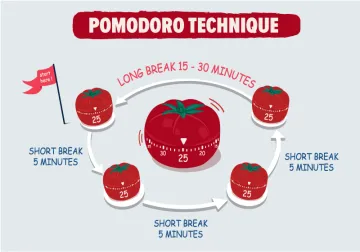Use Procrastination to Your Advantage with the Pomodoro Technique
Sometimes the challenge to getting work done is just starting

New Africa via Adobe Stock License
Sometimes a task or project can seem so big that it's hard to get started. Or maybe you need to study a subject that just isn't that interesting to you. The Pomodoro Technique is an easy strategy you can use to get started, and it's especially helpful if you tend to procrastinate. It leverages the sense of urgency by limiting your time to complete a task to small intervals and encouraging focus.
How Does it Work?
The Pomodoro Technique was developed by Francesco Cirillo in the late 80s as a study method while he was in college. He used a kitchen timer in the shape of a tomato (a pomodoro in Italian) to break his work into to 25-minute chunks. After 25 minutes of work, he would set a new timer for 5 minutes and take a break. Then he would set another timer for 25-minutes and work again. After four sets, or pomodoros, he would take a longer 20-minute break. The key during the pomodoros is to limit distractions like your phone, other apps on a computer, or anything else that may take away your attention. The goal is to get a small chunk of focused time to help you get moving on your larger project, and then build on that momentum with consecutive chunks of time. You also don't need an actual pomodoro timer. You can use your phone, a watch, or an app if that's easiest to try it.

POSMGUYS via Adobe Stock License
When Should I Use It?
You can use it all the time. Maybe you need to review lecture notes. A pomodoro timer can be an efficient way to block out a certain amount of time for distraction-free review. Maybe you need to study for a test. You could use each pomodoro to focus on a new topic. Maybe you need to write a paper. You could break up your tasks like outlining, researching, writing, reading, etc. into different pomodoros (maybe of varying times based on the task). The point is that you can use it for many different tasks, and can vary it to your preferences.
Variations
The Pomodoro technique works best as a template to get you started. What works for you may vary, so you can change the template to fit your needs. If you are having trouble getting started with a project or task, you can use it to build momentum. You may find that once you get started, after two or three pomodoros, you don't want to keep taking breaks. You can choose to continue for a longer time if you are finding you are in a flow, or are working on a task that needs longer focus periods.
More Information
You can find more information on Francesco Cirillo's site, or NeuYear.net (cited last week). Below is a short video that can also walk you through the process.

